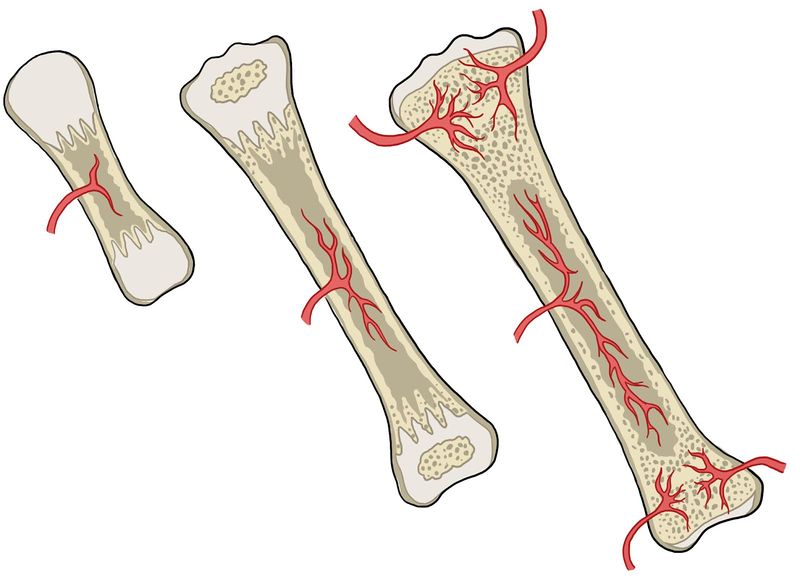READ: The Skeletal System
| Site: | Mountain Heights Academy OER |
| Course: | Medical Forensics Q2 |
| Book: | READ: The Skeletal System |
| Printed by: | Guest user |
| Date: | Friday, 15 August 2025, 12:15 AM |
The Skeletal System
Are bones alive?
From seeing a skeleton, you might think that bones are just dead, hollow structures. But in a living person, those hollow spaces are full of living cells. Bones have a blood supply and nerves. Bones are a living tissue.
Your Skeleton
How important is your skeleton? Can you imagine your body without it? You would be a wobbly pile of muscle and internal organs, and you would not be able to move.
The adult human skeleton has 206 bones, some of which are named below ( Figure below ). Bones are made up of living tissue. They contain many different types of tissues. Cartilage is found at the end of bones and is made of tough protein fibers. Cartilage creates smooth surfaces for the movement of bones that are next to each other, like the bones of the knee.
Ligaments are made of tough protein fibers and connect bones to each other. Your bones, cartilage, and ligaments make up your skeletal system .
The skeletal system is made up of bones, cartilage, and ligaments. The skeletal system has many important functions in your body. What bones protect the heart and lungs? What protects the brain?
CK-12 Foundation, http://creativecommons.org/licenses/by-nc-sa/3.0/
Function and Growth of Bones
Functions of Bones
Your skeletal system gives shape and form to your body, but it also plays other important roles. The main functions of the skeletal system include:
- Support. The skeleton supports the body against the pull of gravity, meaning you don't fall over when you stand up. The large bones of the lower limbs support the rest of the body when standing.
- Protection. The skeleton supports and protects the soft organs of the body. For example, the skull surrounds the brain to protect it from injury. The bones of the rib cage help protect the heart and lungs.
- Movement. Bones work together with muscles to move the body.
- Making blood cells. Blood cells are mostly made inside certain types of bones.
- Storage. Bones store calcium. They contain more calcium than any other organ. Calcium is released by the bones when blood levels of calcium drop too low. The mineral, phosphorus is also stored in bones.
Bone Growth
Early in human development, the skeleton consists of only cartilage and other connective tissues. At this point, the skeleton is very flexible. As the fetus develops, hard bone begins to replace the cartilage, and the skeleton begins to harden. Not all of the cartilage, however, is replaced by bone. Cartilage remains in many places in your body, including your joints, your rib cage, your ears, and the tip of your nose.
A baby is born with zones of cartilage in its bones that allow growth of the bones. These areas, called growth plates , allow the bones to grow longer as the child grows. By the time the child reaches an age of about 18 to 25 years, all of the cartilage in the growth plate has been replaced by bone. This stops the bone from growing any longer. Even though bones stop growing in length in early adulthood, they can continue to increase in thickness throughout life. This thickening occurs in response to strain from increased muscle activity and from weight-lifting exercises.
Vocabulary
- bone marrow : Soft connective tissue in spongy bone; makes blood cells.
- cartilage : Dense connective tissue that provides a smooth surface for the movement of bones at joints.
- compact bone : Dense outer layer of bone that is very hard and strong.
- growth plate : Area of growing tissue near the ends of the long bones in children and adolescents.
- ligament : Band of fibrous connective tissue that holds bones together.
- periosteum : Tough, fibrous membrane that covers the outer surface of bone.
- skeletal system : All the body's bones, cartilage, and ligaments.
- spongy bone : Light, porous inner layer of bone that contains bone marrow.
Summary
- Bones, cartilage, and ligaments make up the skeletal system.
- Functions of the skeletal system include providing support, protecting the soft organs of the body, aiding in movement, and making blood cells.
CK-12 Foundation, http://creativecommons.org/licenses/by-nc-sa/3.0/

